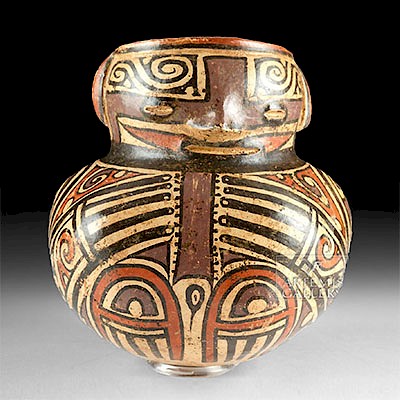Large Gandharan Stucco Buddha
Lot 44b
About Seller
Artemis Fine Arts
686 S Taylor Ave, Ste 106
Louisville, CO 80027
United States
Selling antiquities, ancient and ethnographic art online since 1993, Artemis Gallery specializes in Classical Antiquities (Egyptian, Greek, Roman, Near Eastern), Asian, Pre-Columbian, African / Tribal / Oceanographic art. Our extensive inventory includes pottery, stone, metal, wood, glass and textil...Read more
Categories
Estimate:
$6,000 - $9,000
Absentee vs Live bid
Two ways to bid:
- Leave a max absentee bid and the platform will bid on your behalf up to your maximum bid during the live auction.
- Bid live during the auction and your bids will be submitted real-time to the auctioneer.
Bid Increments
| Price | Bid Increment |
|---|---|
| $0 | $25 |
| $300 | $50 |
| $1,000 | $100 |
| $2,000 | $250 |
| $5,000 | $500 |
| $10,000 | $1,000 |
| $20,000 | $2,500 |
| $50,000 | $5,000 |
| $100,000 | $10,000 |
| $200,000 | $20,000 |
About Auction
By Artemis Fine Arts
Nov 8, 2018
Set Reminder
2018-11-08 10:00:00
2018-11-08 10:00:00
America/New_York
Bidsquare
Bidsquare : Ancient / Ethnographic From Around The World
https://www.bidsquare.com/auctions/artemis-gallery/ancient-ethnographic-from-around-the-world-3598
Ancient art from Egypt, Greece, Italy and the Near East, as well as Asian, Pre-Columbian, Native American, African / Tribal / Oceanic, Spanish Colonial, Russian Icons, Fine art, much more! Artemis Fine Arts info@artemisfinearts.com
Ancient art from Egypt, Greece, Italy and the Near East, as well as Asian, Pre-Columbian, Native American, African / Tribal / Oceanic, Spanish Colonial, Russian Icons, Fine art, much more! Artemis Fine Arts info@artemisfinearts.com
- Lot Description
Central Asia, Pakistan and Afghanistan, Gandharan Empire, ca. 3rd to mid 5th century CE. An elegant stucco youthful Buddha - also known as Shakyamuni Buddha, Gautama Buddha or Siddhartha Gautama, the crown prince of the Shakya Kingdom, who ultimately achieved Enlightenment and issued teachings upon which Buddhism was founded. The Buddha sits with his legs crossed before a mandorla, his hands resting in his lap in the Dhyana Mudra, as if he is meditating beneath the Bodhi tree. The Buddha's face is finely modeled with elegant features including heavy-lidded, downcast eyes, an elegantly arched browline leading to an aquiline nose, gently smiling closed lips, and stretched earlobes symbolizing his rejection of the material world in pursuit of spiritual enlightenment - all topped by an incised curly coiffure with a large ushnisha symbolizing his newfound knowledge upon Enlightenment. Red pigment remains on his robes and face as well as black pigment on his coiffure and eyebrows. A special example of Greco-Buddhist art that demonstrates a strong syncretism between eastern and western traditions. Size: 8.625" W x 10.875" H (21.9 cm x 27.6 cm); 12.75" H (32.4 cm) on included custom stand.
The spiritual quality of his visage is simultaneously complemented by the naturalism of the anatomy. Notice how skillfully the sculptor rendered details such as the philtrum (vertical groove in midline above the upper lip), the Cupid's bow of the upper lip, the tear troughs between the eyes and nose, the nasal bridge, and the contours of his cheeks and chin. At the same time there is an undeniable stylization to details such as the incised, squared off curls of his coiffure.
Gandharans are famous for schist and stucco carvings, with stucco replacing schist as the dominant material around the 3rd century CE. Vast monastic institutions like those at Takht-i-Bahi, Sahri-Bahlol, Jamal Garhi, Ranigat, and Thareli were decorated by skilled artisans with stucco representations of important figures, religious scenes, and artistic dedications. The stucco medium allowed artists more freedom to render more lifelike features. During this time, Gandhara was exceptionally wealthy, profiting from trade along the Silk Road which resulted in a flowering of the arts.
Alexander the Great conquered Gandhara in 330 BCE and with the help of the Indo-Greek kings introduced classical traditions that would influence Gandharan art for the following seven centuries. The stylized curly Mediterranean hair and top knot that derive from the Apollo Belvedere (330 BCE), as well as the sensitive modeling of that tranquil visage displayed in this piece, for example, exhibit this classical influence.
Provenance: private East Coast, USA collection
All items legal to buy/sell under U.S. Statute covering cultural patrimony Code 2600, CHAPTER 14, and are guaranteed to be as described or your money back.
A Certificate of Authenticity will accompany all winning bids.
We ship worldwide and handle all shipping in-house for your convenience.
#139785Surface wear to Buddha commensurate with age. Nice remains of red, white, and black pigment. Right knee reattached. Losses to surface and peripheries of mandorla as shown.Condition
- Shipping Info
-
All shipping is handled in-house for your convenience. Your invoice from Artemis Gallery will include shipping calculation instructions. If in doubt, please inquire BEFORE bidding for estimated shipping costs for individual items.
-
- Buyer's Premium



 EUR
EUR CAD
CAD AUD
AUD GBP
GBP MXN
MXN HKD
HKD CNY
CNY MYR
MYR SEK
SEK SGD
SGD CHF
CHF THB
THB














